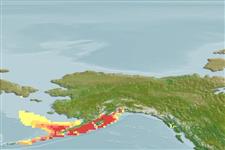Teleostei (teleosts) >
Perciformes/Cottoidei (Sculpins) >
Cyclopteridae (Lumpfishes) > Eumicrotreminae
Etymology: Eumicrotremus: Greek, eu = good + Greek, mikros = little, small + Greek, trema = hole (Ref. 45335).
More on authors: Gilbert & Burke.
Environment: milieu / climate zone / depth range / distribution range
Ecology
Marine; demersal; depth range 69 - 170 m (Ref. 43939). Polar
North Pacific: southeastern Bering Sea and central Aleutian Islands to northern Gulf of Alaska.
Size / Weight / Age
Maturity: Lm ? range ? - ? cm
Max length : 7.4 cm TL male/unsexed; (Ref. 43939)
Short description
Identification keys | Morphology | Morphometrics
Dorsal spines (total): 6 - 7; Dorsal soft rays (total): 10 - 11; Anal spines: 0; Anal soft rays: 9 - 10. Head and body covered with tubercles smaller than pupil, some with rosettes of short spines protruding and others concealed, forming bumps. Few or no spiny tubercles on throat. First dorsal fin covered with thick skin (Ref. 43939).
Found on sand, broken shell and gravel bottoms (Ref. 43939).
Life cycle and mating behavior
Maturities | Reproduction | Spawnings | Egg(s) | Fecundities | Larvae
Mecklenburg, C.W., T.A. Mecklenburg and L.K. Thorsteinson, 2002. Fishes of Alaska. American Fisheries Society, Bethesda, Maryland. xxxvii +1037 p. (Ref. 43939)
IUCN Red List Status (Ref. 130435)
Threat to humans
Harmless
Human uses
Tools
Special reports
Download XML
Internet sources
Estimates based on models
Preferred temperature (Ref.
123201): 3.4 - 5.7, mean 4.4 °C (based on 49 cells).
Phylogenetic diversity index (Ref.
82804): PD
50 = 0.5000 [Uniqueness, from 0.5 = low to 2.0 = high].
Bayesian length-weight: a=0.02089 (0.00774 - 0.05639), b=3.03 (2.79 - 3.27), in cm total length, based on LWR estimates for this (Sub)family-body shape (Ref.
93245).
Trophic level (Ref.
69278): 3.2 ±0.4 se; based on size and trophs of closest relatives
Resilience (Ref.
120179): High, minimum population doubling time less than 15 months (Preliminary K or Fecundity.).
Fishing Vulnerability (Ref.
59153): Low vulnerability (10 of 100).
